There are 48 spiders that are common in Michigan. Chances are you will come across one or more of these spiders in the area.
Wondering what spider you just found in your shed or you are curious about the spider you saw in your garden, continue reading to find out more.
Table of Contents
1. Bold Jumping Spider
Scientific name: Phidippus audax
Common name: daring jumping spider, bold jumping spider
The bold jumping spider is a member of the Salticidae family and is a small spider that has the ability to jump four times its body length. The jumping gives them the opportunity to ambush prey and escape predators.

They are not easy to catch, therefore bites from one of these spiders is exceptionally rare. Their bite is not venomous and will cause a stinging sensation.
They have bold colors with a white line that runs across the upper abdomen with two white dots close to the rear.
They are found in a range of habitats including homes, cars, and offices.
2. Tan Jumping Spider

Scientific name: Platycryptus undatus
Common name: tan jumping spider
Tan jumping spiders are members of the Salticidae family and rely on jumping to escape predators and ambush their prey.
They wander to find their next meal and do not rely on webs to ensnare their prey.
They leap towards the prey, shooting out a strand of silk, which captures the prey and reduces the risk of it escaping.
They are curious spiders and tend to be friendly when handled gently. They do not bite unless you handle them roughly.
3. Grass Spiders

Scientific name: Genus Agelenopsis
Common name: American grass spiders, grass spiders
Grass spiders are common during the summer months.
They belong to a family of Funnel Web Weavers and make cave-like webs on grass. Their webs can also be found in shrubs, building crevices, and fences.
These spiders move quickly and catch prey, dragging them into the web.
They are often mistaken as wolf spiders with a similar color pattern. They have two black lines that run down the side of their body.
They are unlikely to bite and their poison is not venomous.
They are mostly visible in the rain when the rain droplets land on their webs and are reflected by the light.
4. Cross Orbweaver

Scientific name: Araneus diadematus
Common name: European garden spider, diadem spider, orangie, cross spider, crowned orb weaver, pumpkin spider
Cross orb weavers have a white cross on their abdomen.
They are originally from Europe and were transported to North America.
They are not considered pests or threats and are not harmful to humans.
Females are double the size of the male with some evidence that the female may eat the male after mating.
They are brown with short hairs on their legs with tan and brown bands.
They spend their days working on creating a new web and can be found in woodlands, meadows, grasslands, gardens, deserts, and forests.
5. Dark Fishing Spider

Scientific name: Dolomedes tenebrosus
Common name: dark fishing spider
The dark fishing spider can be found near water.
They are large with leg spans that can reach up to 3 inches (7.5cm).
They are members of the Nursery Web family and lay their eggs on a mat that is then wrapped into a ball of webbing. The female carries the sac while she searches for a safe place, building a web and attaching the sac to it, while she stands guard until the eggs hatch.
They can bite, but their venom is not considered dangerous, no worse than a bee sting.
They ambush their prey on the surface or under the water. They are known for hunting tadpoles and small fish.
The hairs on the spider’s body, allow them to trap an air bubble, which helps them breathe while submerged under water for up to thirty minutes.
6. Zebra Jumping Spider

Scientific name: Salticus scenicus
Common name: zebra jumping spider
The zebra jumping spider is a member of the Salticidae family with females being larger than the male.
Female zebra jumping spiders can grow up to 9mm in length, while males grow to around 6mm.
They have black and white hairs that form stripes with large eyes.
They ambush their prey rather than ensnaring them in their webs. Once they have their prey, they drag it back to the web, where they can eat at their leisure and in safety.
7. American Nursery Web Spider

Scientific name: Pisaurina mira
Common name: American Nursery Web Spider
Nursery web spiders are spiders that create a nursery for their eggs and young.
Females are excellent mothers and carefully carry the sac in their fangs while she builds the perfect web nursery in high weeds and shrubs.
They often suspend the sac from leaves, making them less visible and harder to reach. The sac is then surrounded by webbing and she stands guard until the eggs have hatched.
The American nursery web spider is an ambush predator and does not rely on its web to capture prey.
Females are often found among leaf litter with a light brown to tan body with a dark streak that runs down the center. Males look the same, but their streak is lighter.
8. Yellow Garden Spider

Scientific name: Argiope aurantia
Common name: yellow garden spider, black and yellow garden spider, golden garden spider, writing spider, zigzag spider, zipper spider, corn spider, banana spider, Steeler spider, McKinley spider
Yellow garden spiders were first described in 1833 and are common in the United States with yellow and black abdomens and a white cephalothorax.
Females are larger than the males, growing to 1.10 inches (28mm) with males growing to 0.35 inches (9mm) in length.
They will bite if provoked, but their venom is harmless and no worse than a bee sting.
They are not an aggressive species, though they will bite if you grab them.
9. Dimorphic Jumping Spider

Scientific name: Maevia inclemens
Common name: Dimorphic Jumping Spider
This jumping spider comprises of two variants, which is where the name Dimorphic comes from, which means “two forms.”
Males are black with yellow legs or tan with red on the abdomen and the two forms can look completely different. Females look the same as a pale version of a tan male.
Their bodies have short hairs.
They have the ability to jump four times their body length, pouncing on prey or jumping away from predators.
It is a very small spider that is noticeable due to its fast movements and coloration.
10. Orchard Orbweaver

Scientific name: Leucauge venusta
Common name: orchard orb weaver
The orchard orb weaver is a long-jawed orb weaver that hangs upside down from its webs.
They have leaf green sides and legs with spots of yellow and black on the thorax and a silver with black or brown streaks on the top.
They usually have bright orange, red or yellow spots near the back of the abdomen.
11. Northern Yellow Sac Spider

Scientific name: Cheiracanthium mildei
Common name: Northern yellow sac spider
The northern yellow sac spider is pale green to tan with dark brown chelicerae and palpi.
Males grow to around 10mm in body size with the legs ending in a double claw with the front legs being longer than the rest.
They can bite, so be careful, but their bites are mild, similar to that of a bee.
These spiders are native to North Africa and Europe and were introduced to the United States. They are found outdoors and in homes.
12. Asiatic Wall Jumping Spider

Scientific name: Attulus fasciger
Common name: Asiatic Wall Jumping Spider
The Asiatic wall jumping spider grows to around 0.16 inches (4mm) in size with males being slightly smaller with a slender abdomen.
They are originally from north and west Asia and were introduced to North America, where they were first described in the 1950s.
They are mottled brown and gray, making it easy for the spider to camouflage itself in man-made structures.
They hunt at night and are often found hanging around outside lighting, waiting for insects attracted by the light.
13. Eastern Parson Spider

Scientific name: Herpyllus ecclesiasticus
Common name: eastern parson spider
The parson spider has a white stripe on the abdomen, that looks like a ruffled necktie used in the clergy in the eighteenth century.
These medium-sized spiders are fast and roam walls and floors at night searching for insects. They are hairy spiders and ambush their prey.
They hide under debris and rocks during the day and are often seen in buildings and homes.
The venom is not considered lethal, though there are reports of allergic reactions in some people.
14. Spotted Orbweaver

Scientific name: Neoscona crucifera
Common name: Hentz orbweaver, spotted orbweaver, barn spider
Spotted orb weavers are known for their orb-shaped webs that can be up to two meters in diameter.
They hide during the day, usually remaking or repairing their webs.
They vary in color from tan to red and orange or brown and yellow. Some have a visible pattern on their body, while others have no pattern.
They have short bristles on their legs, head, abdomen, and thorax.
They are most commonly observed in fields, gardens, woodlands, parks, and backyards from May to August.
15. Goldenrod Crab Spider

Scientific name: Misumena vatia
Common name: goldenrod crab spider, flower (crab) spider
Goldenrob crab spiders are able to camouflage themselves to defend themselves against predators. They will bite to protect themselves and can change color over a period of a few days, helping them blend in with their surroundings.
They ambush their prey by jumping on them, rather than spinning a web. They sit in the center of flowers and wait for butterflies and bees that come to collect pollen.
Males are smaller than the female with black front legs and green back legs with a white abdomen with two red lines that run down the center.
Females are white or yellow and they may or may not have the red banding. Females have lighter-colored legs.
16. Spined Micrathena

Scientific name: Micrathena gracilis
Common name: spined micrathena, castleback orbweaver
The spined micrathena has pointed ridges on the abdomen, which makes them less appealing to predators.
They are brown, black, and white in color with colors varying from one individual to the next.
Males do not have sharp ridges and tend to be more black or white in color with a slender abdomen.
They are mostly observed in woods or forests during the summer months.
17. Long-bodied Cellar Spider

Scientific name: Pholcus phalangioides
Common name: daddy long-legs spider, long-bodied cellar spider, skull spider
The long-bodied cellar spider has a long tubular abdomen with rounded bottom and tapered jawline.
It is also referred to as the skull spider or Daddy Long legs.
They often bounce in their webs, blurring themselves to make themselves harder to see, disorientating predators.
They hang upside down waiting for insects to climb into their webs.
Their mouth parts are exceptionally small, making it almost impossible for them to bite humans. Their venom is not dangerous and their fangs are too small to insect the venom into any human that catches them.
18. Triangulate Combfoot

Scientific name: Steatoda triangulosa
Common name: triangulate cobweb spider, triangulate bud spider, triangulate combfoot
The triangulate combfoot is a common house spider that can be identified for the triangle pattern on the abdomen.
They are not aggressive towards humans with venom that is not considered dangerous.
They spend their days remaking their webs, relying on vibrations to let them know when the prey has been ensnared.
19. Flea Jumping Spider

Scientific name: Naphrys pulex
Common name: Flea Jumping Spider
The flea jumping spider has gray and black on the top of the abdomen, legs, and cephalothorax with orange on the sides.
They are often observed in long grass and in wooded areas where there is an abundance of leaf litter. They can be found in buildings and on bark, where they feed on insects.
As with other jumping spiders, this is an ambush predator that does not rely on its web to ensnare its prey, but rather on its ability to jump up to four times its body length, shooting out a string of silk, which ensnares the prey making it harder for it to escape.
20. Grey Cross Spider

Scientific name: Larinioides sclopetarius
Common name: bridge spider, gray cross spider
The gray cross spider, also known as the bridge spider, is related to the orb weaver.
They are often found on bridges, which are near or over the water.
Females are larger than the male growing to around 14mm with males at 9mm.
Their webs can reach up to 70cm in diameter.
They are attracted to light, which has attracted these spiders to urban areas. They often hide in their webs during the day waiting for prey to get ensnared.
Males tend to inhabit the females’ webs. Males are mostly observed during summer, while females can remain active until November.
21. Common House Spider
Scientific name: Parasteatoda tepidariorum
Common name: common house spider, American house spider
The common house spider creates webs that are what we know as Halloween webs, messy tangles of silk which can be found around windows, in the attic, and basement. It is common for females to have their webs close to each other.
These are comb footed spiders with long legs with comb like hairs on the ankles.
They can remain motionless for extended periods, patiently waiting for prey, while avoiding being seen by predators and humans.
They have rounded abdomens which are brown with white and dark lines and patches.
These small spiders won’t bother you and are not at aggressive. They will bite if handled roughly, which will be painful, but the pain, redness, and swelling will only last a couple of days.
22. Furrow Orbweaver

Scientific name: Larinioides cornutus
Common name: furrow spider, furrow orb spider, foliate spider
Furrow orb weavers are small spiders with females growing up to 14mm and males to 9mm in body length. They can be up to 35mm in leg span.
They have oval-shaped abdomens in gray, black, or red with the carapace having a light shaded arrow, along with the legs, which also have an arrow pattern.
The tiny hairs on their legs let them pick up vibrations, which helps them sense when there are predators or prey close by.
They are usually found near water, where they spin their webs between the shrubs and grass, hiding during the day.
23. Six-spotted Fishing Spider
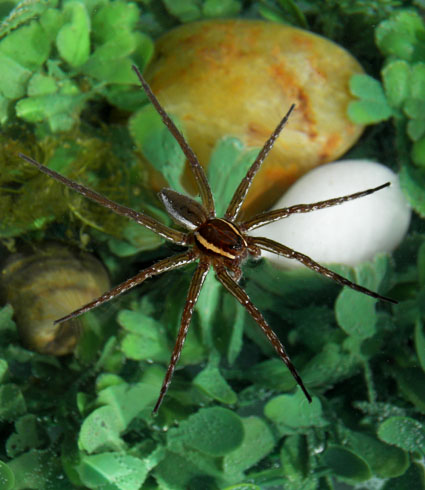
Scientific name: Dolomedes triton
Common name: six-spotted fishing spider, dock spider
Six spotted fishing spiders are part of the nursery web family and are most common in wetland habitats where they can be observed on the surface of the water.
These large spiders have distinct markings and eight eyes, giving them excellent vision.
The body is brown to gray with white or pale cream stripes which run down either side of the cephalothorax.
They have light spots and lines on the side of the abdomen.
Females can grow to 0.79 inches (20mm) in body length, with males growing to 0.51 inches (13mm) in length.
24. Broad-Faced Sac Spider

Scientific name: Trachelas tranquillus
Common name: broad-faced sac spider
Broad-faced sac spiders are from the Trachelidae family and are native to the Eastern United States.
These outdoor spiders usually make their way into homes during fall, when the temperatures start to drop.
They are dark brown or red in color and are a solid color. Their legs can be tan, brown or red with the front pair being darker than the rest.
Females can grow to 10mm and are larger than the male. Their leg span can reach up to 16mm.
25. Banded Garden Spider

Scientific name: Argiope trifasciata
Common name: banded garden spider, banded orb weaving spider
Banded garden spiders are members of the orb-weaver family and build orb-shaped webs in garden beds, carefully placed between plants.
The spider sits upside down in the center waiting for prey to get ensnared.
Colors can vary with some being black with yellow and white banding and others being red to brown with white banding. The legs have banding that matches the body color.
They are mostly observed in the summer with males being half the size of females, where they sit on the side of the female’s web just before mating.
Females are known to give a painful bite if she is guarding eggs and feels threatened.
26. Northern Crab Spider

Scientific name: Mecaphesa asperata
Common name: Northern crab spider
Northern crab spiders have the ability to walk forwards, backward, and sideways.
They hunt in flowers where they search for pollinating prey.
Their bodies are covered in short spines with a white ocular region and red streaks on the abdomen with a V shape at the back of the abdomen pointing towards the rear.
27. Six-spotted Orbweaver

Scientific name: Araniella displicata
Common name: Six-spotted orb weaver
Six-spotted orb weavers are members of the Araneidae family and are attractive maroon and white spiders with a body size of around 5mm.
The identifying feature is the six black spots with white rims on the abdomen.
Orb weavers are known for their large webs with the spider placed upside down patiently waiting for prey to get ensnared.
While they can give a painful bite, it is not dangerous to humans and the pain, redness, and swelling can be managed at home with an ice pack.
28. Woodlouse Spider

Scientific name: Dysdera crocata
Common name: woodlouse hunter, sowbug hunter, sowbug killer, pillbug hunter, slater spider
Female woodlouse spiders can grow up to 0.59 inches (15mm) in body length, with males being smaller and growing to around 0.39 inches (10mm) in length.
They are orange to dark red on the cephalothorax and legs with a yellow to brown or pale beige abdomen.
They are mostly observed outdoors under plant pots, leaf litter, rocks, and logs. They can usually be found in a warm area close to woodlice.
They hunt at night and do not spin webs to ensnare their prey.
29. Bronze Jumping Spider
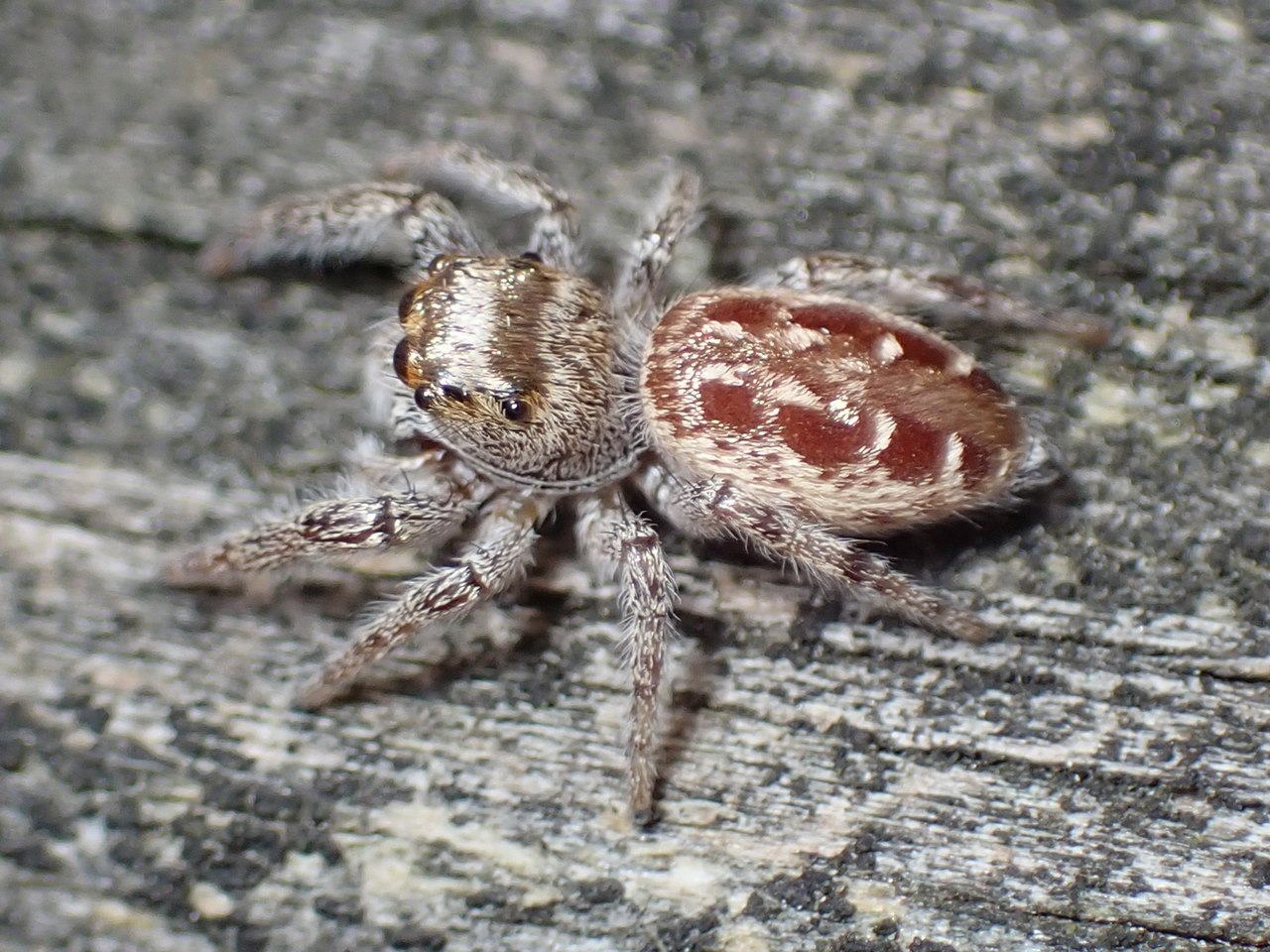
Scientific name: Eris militaris
Common name: bronze jumper, bronze lake jumper
Bronze jumping spiders are common in the United States with the ability to jump up to four times their body length when ambushing prey or trying to escape predators.
They do not spin webs in order to capture prey, they are wanderers and once they have their prey under control, they drag them back to their web where they can store them and eat at their leisure in safety.
They are not dangerous to humans and are small and curious. They will bite if they are roughly handled, which can cause redness, pain, and swelling for a couple of days.
30. Common Candy-striped Spider

Scientific name: Enoplognatha ovata
Common name: common candy-striped spider
Common candy-striped spiders belong to the Theridiidae family and are native to Europe and were later introduced to the United States.
They can grow up to 6mm in leg span with translucent legs and a rounded abdomen which can vary in pattern and color.
Background colors are usually green, cream, or white with a row of dark spots and a red stripe or two red stripes that end in a V shape.
31. Shamrock Orbweaver
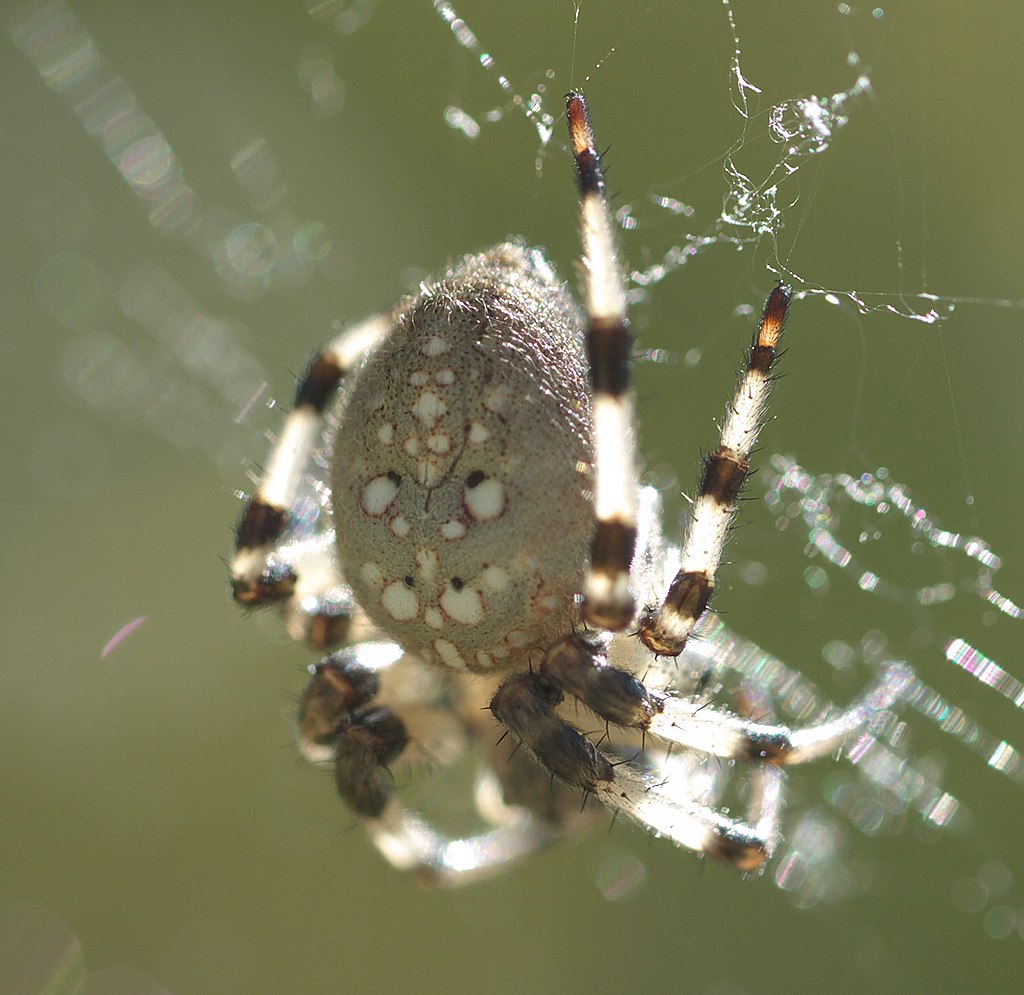
Scientific name: Araneus trifolium
Common name: Shamrock orb weaver
Shamrock orb weavers have black and white legs with the body color varying from one individual to the next.
They have a rounded abdomen in yellow, red, purple, or white with some white specks on the abdomen, which may or may not be visible along the mid line.
They sit upside down in their webs, which they create new every single day.
They are often observed in woodlands, near streams, creeks, and marshes, along with gardens and parks.
They are excellent in helping to reduce insect pests.
32. Arabesque Orbweaver

Scientific name: Neoscona arabesca
Common name: arabesque orbweaver
Arabesque is a ballet position, along with an ornate design of curves and swirls. The arabesque orb weaver can vary in color from brown to orange and gray to black.
Females have a rounder abdomen than the slender males, they all have the same dashes and lines down the center of the abdomen. They have black commas on the sides of the decoration.
They are small spiders and not aggressive, they are likely to run before they bite.
Females hide under leaves, while males are often not too far away.
33. Marbled Orbweaver

Scientific name: Araneus marmoreus
Common name: marbled orbweaver, pumpkin spider
Marbled orb weavers have a marbled pattern of coloration on the abdomen with an orange head and orange upper legs with black and white banding on the lower legs.
The abdomen can be a mixture of colors with orange and yellow or black and orange, black and white, or black and yellow.
They are often observed in wooded areas near a water source, where they build their large webs on reeds, tall grasses, and reeds.
They are mostly active in summer and fall.
They will drop to the ground if they sense any danger and hide until the threat has passed.
While they can grow to a large size, they are not an aggressive species.
34. Striped Fishing Spider
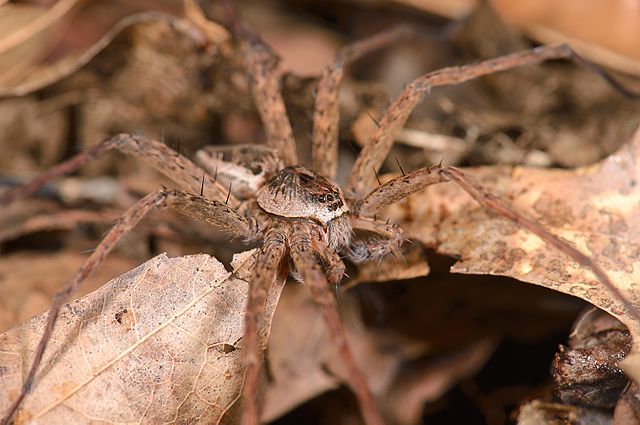
Scientific name: Dolomedes scriptus
Common name: Striped fishing spider
Striped fishing spiders are common in the United States and Canada.
The females grow up to 6cm in leg span with males being smaller. They are brown in color with light stripes on the legs and down either side of the body.
These spiders are found near water where they feed on tadpoles and marine inverts.
35. White-jawed Jumping Spider
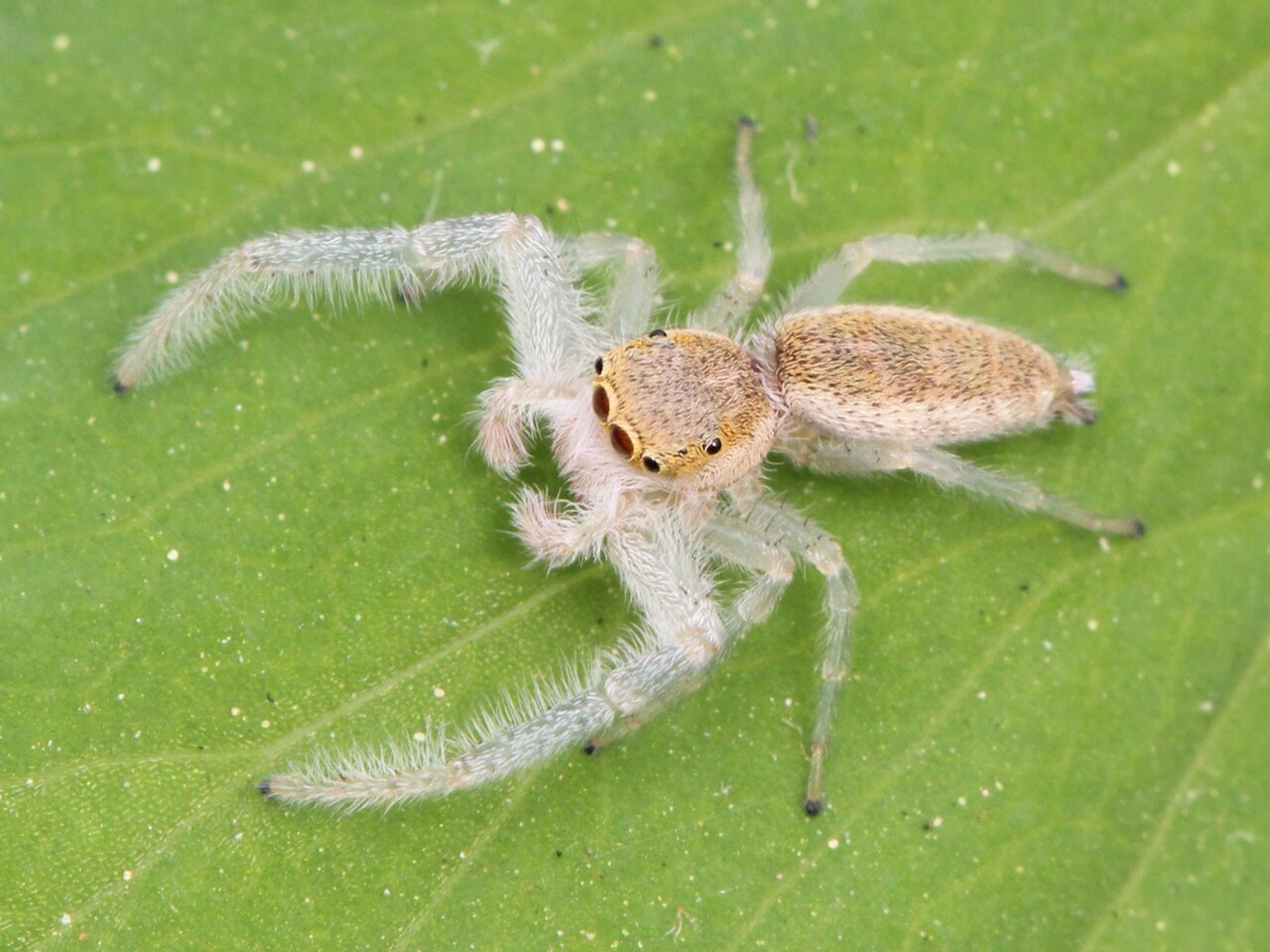
Scientific name: Hentzia mitrata
Common name: white-jawed jumping spider
White jawed jumping spiders belong to the Salticidae family and can grow up to 4mm in body length with the female being larger than the male.
They are light brown with copper-colored hairs. There is a white mark on the back of the carapace and on the edge of the legs and body.
Jumping spiders are ambush predators and will jump four times their body length to catch prey or escape threats.
They are not harmful to humans.
36. Bowl-and-doily Spider
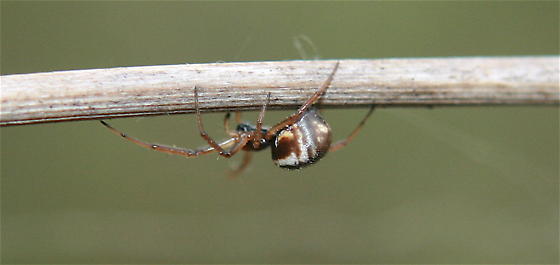
Scientific name: Frontinella pyramitela
Common name: bowl and doily spider
Bowl and doily spiders are sheet weavers common in North America.
These small spiders grow to 4mm in body length weaving complete sheet webs with an inverted dome (bowl) at the base. The spider hangs under the bowl. The webs are often seen in shrubs and fields.
They are red to brown in color with yellow on the legs and a decorative abdomen filled with white dots and short hairs on the sides.
They are mostly active in summer and early fall.
37. Shoreline Wolf Spider

Scientific name: Arctosa littoralis
Common name: beach wolf spider, shoreline wolf spider
Shoreline wolf spiders are members of the Lycosidae family and are common in North America where they live in sandy habitats, such as riverbanks and beaches, where they blend into their surroundings.
They are not often observed due to their excellent camouflage.
38. Tuft-legged Orbweaver

Scientific name: Mangora placida
Common name: Tuft-legged Orbweaver
The tuft-legged orb weaver creates a tighter web than other orb weavers, which enables it to ensnare smaller insects. They build vertical webs.
The spiders have hairs on their legs, which helps them navigate the web.
They are mottled brown in color, which helps them blend into their surroundings.
They are usually observed in meadows, fields, and tall grasses, sometimes found in back yards.
39. Common White-cheeked Jumping Spider

Scientific name: Pelegrina proterva
Common name: common white-cheeked jumping spider
The common white-cheeked jumping spider is found in the eastern United States and can grow up to 5.6mm in females and 4.2mm in males.
They are wandering spiders that ambush their prey by jumping at them while releasing a single silk, which helps to ensnare the prey, which can then be dragged back to their web and consumed later.
40. American Green Crab Spider

Scientific name: Misumessus oblongus
Common name: American Green Crab Spider
The American green crab spider has the ability to walk in all directions; forwards, backward, and sideways.
They have long front legs which help them grab insects that are collecting pollen from flowers.
They are usually neon green in color and their color and small size help them hide in the petals of flowers.
They climb on plants searching for prey and are often observed on flowers, in fields, and shrublands.
41. Peppered Jumping Spider

Scientific name: Pelegrina galathea
Common name: peppered jumping spider
Peppered jumping spiders are members of the Salticidae family and are endemic to North America where they can be found in grassy areas with plenty of sunshine.
These peppered colored spiders have the ability to jump great distances to ambush prey or escape predators.
They are not considered medically significant and any bite can be managed at home with a cold press on the bite site to reduce pain, swelling, and redness.
42. Western Lynx Spider

Scientific name: Oxyopes scalaris
Common name: western lynx spider
Western lynx spiders are members of the Oxopidae family and are small spiders with spiny legs.
They are beneficial in gardens and agricultural fields where they feed on insect pests.
They hunt like cats, slowly stalking and then ambushing their prey, by pouncing on them.
They are not considered medically significant, though they can give a painful bite if threatened.
43. Nordmann’s Orbweaver

Scientific name: Araneus nordmanni
Common name: Nordmann’s Orbweaver
This spider belongs to the Araneidae family and is common in North America, known for its large orb-shaped webs.
The spider then sits upside down in the web waiting for prey to be ensnared. They spend the majority of their day repairing and remaking their webs.
44. Brilliant Jumping Spider

Scientific name: Phidippus clarus
Common name: Brilliant jumping spider
Brilliant jumping spiders can be identified by their rectangular-shaped carapace with females being larger than the males, growing to around 0.159 inches (4.05mm) in length. Males average around 0.126 inches (3.20mm).
They are red to brown in color, though there are some that are yellow or brown with dark markings.
They are commonly observed in old fields, where they live among flowers, often sharing habitats with crab spiders.
45. Drumming Sword Wolf Spider

Scientific name: Gladicosa gulosa
Common name: Drumming Sword Wolf Spider
Brown, gray, and black nuances are combined in the multicolored appearance of Drumming Sword Wolf Spiders.
This hairy species shows long hairy legs and a body with a central bright brown stripe.
Gray nuances dominate its body while black borders are seen along both sides of its central brown stripe.
Much of the coloring of the species helps it blend in with the leaves it moves about in forests.
Leaves play an important role in the life of Drumming Sword Wolf Spiders as the species shows.
Females tap their front legs on the leaves in a drumming motion, part of their complex breeding strategies.
The vibrating sounds are believed to attract potential male mates.
46. Wetland Giant Wolf Spider

Scientific name: Tigrosa helluo
Common name: Wetland Giant Wolf Spider
Associated with the humid habitats of Michigan, Wetland Giant Wolf Spiders mostly live next to water.
They inhabit grassland and wetlands and they may never leave these areas as there are plenty of insects for them to feed on here.
Some of their preferred insects here include mosquitoes. Even the spiders themselves serve as food for local predatory bugs such as various mantises.
This is a dark spider that uses its dark appearance to hide in plain sight.
Females rely on their spider webs for food, together with their ambushing techniques. Males don’t build spider webs and need to be quite close to their food insects to catch them.
Brown and black nuances dominate its appearance while a brighter central stripe is seen across its dorsum.
While it does grow up to a size of 1.2 inches, the spider rarely reaches this size in the wilderness.
47. Black Laceweaver

Scientific name: Amaurobius ferox
Common name: Black Laceweavcer
A dark appearance is specific to this species of spider which has made its way to North America from Europe.
Its colors are considerably variable from dark red to all-black.
The Black Lacewear spider is generally small with an adult size ranging between 0.3 and 0.6 inches.
Still, this doesn’t mean the spider cannot bite. Its bite comes with mild pain but it’s not believed to be truly dangerous to humans.
Complications such as spotting swollen skin might lead to a doctor’s visit, on the other hand.
This is one of the spiders of Michigan with a sticky spider web which means more insects get trapped in it than on other spider webs.
48. Rustic Wolf Spider

Scientific name: Trochosa ruricola
Common name: Rustic Wolf Spider
This species of wolf spider is sometimes seen in parks and gardens across the state.
Most of these spiders live in grassland but aren’t as easily spotted here.
Their dark appearance may also make them a species not easy to spot. Mostly black, they do show a partly brown strip on the dorsum and brown legs.
When it comes to size, these spiders can grow quite large, like other wolf spiders. Sometimes measuring over 1 inch in length, they move for food on the ground.
These spiders may be beneficial in eliminating pest bugs in gardens as well as mosquitoes around the house.
Further Reading: